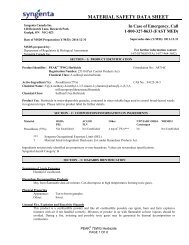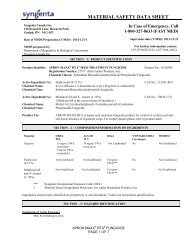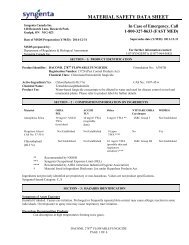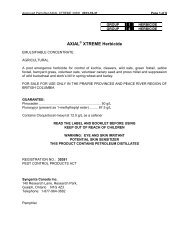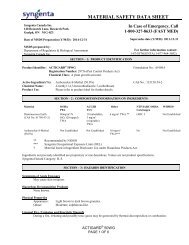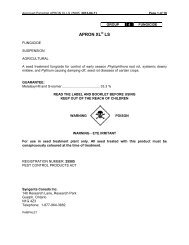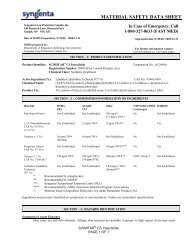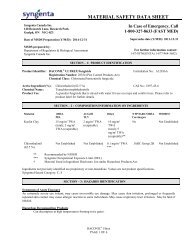Bravo ZN MSDS - Syngenta Crop Protection
Bravo ZN MSDS - Syngenta Crop Protection
Bravo ZN MSDS - Syngenta Crop Protection
Create successful ePaper yourself
Turn your PDF publications into a flip-book with our unique Google optimized e-Paper software.
MATERIAL SAFETY DATA SHEET<br />
<strong>Syngenta</strong> Canada Inc.<br />
140 Research Lane, Research Park<br />
Guelph, ON N1G 4Z3<br />
Date of <strong>MSDS</strong> Preparation (Y/M/D): 2014-12-31<br />
<strong>MSDS</strong> prepared by:<br />
Department of Regulatory & Biological Assessment<br />
<strong>Syngenta</strong> Canada Inc.<br />
In Case of Emergency, Call<br />
1-800-327-8633 (FAST MED)<br />
Supersedes date (Y/M/D): 2011-12-31<br />
For further information contact:<br />
1-87-SYNGENTA (1-877-964-3682)<br />
SECTION – 1: PRODUCT IDENTIFICATION<br />
Product Identifier: BRAVO ® <strong>ZN</strong><br />
Registration Number: 28900 (Pest Control Products Act)<br />
Chemical Class: Chlorinated benzonitrile fungicide.<br />
Formulation No.: A7867G<br />
Active Ingredient (%): Chlorothalonil (38.7 %) CAS NO.: 1897-45-6<br />
Chemical Name : Tetrachloroisophthalonitrile<br />
Product Use:<br />
Water based fungicide concentrate to be mixed with water and used to control diseases in potato<br />
crops. Please refer to product label for further details.<br />
SECTION – 2: COMPOSITION/INFORMATION ON INGREDIENTS<br />
Material<br />
Amorphous Silica<br />
OSHA<br />
PEL<br />
80 mg/m³/ %SiO2<br />
TWA<br />
(total dust)<br />
ACGIH<br />
TLV<br />
10 mg/m³ TWA<br />
(respirable<br />
dust)<br />
Other<br />
NTP/IARC/OSHA WHMIS†<br />
Carcinogen<br />
6 mg/m³ TWA ** IARC Group 3 Not Established<br />
Propylene Glycol<br />
CAS No. 57-55-6<br />
Not Established Not Established 10 ppm<br />
TWA ****<br />
No<br />
Yes<br />
Chlorothalonil<br />
(38.7%)<br />
Not Established Not Established 0.1 mg/m³ TWA<br />
***<br />
IARC Group 2B<br />
Not Established<br />
** Recommended by NIOSH<br />
*** <strong>Syngenta</strong> Occupational Exposure Limit (OEL)<br />
**** Recommended by AIHA (American Industrial Hygiene Association)<br />
† Material listed in Ingredient Disclosure List under Hazardous Products Act.<br />
Ingredients not precisely identified are proprietary or non-hazardous. Values are not product specifications.<br />
<strong>Syngenta</strong> Hazard Category: D, S<br />
SECTION – 3: HAZARDS IDENTIFICATION<br />
Symptoms of Acute Exposure<br />
Harmful if inhaled. Causes eye irritation. May cause an allergic reaction in some individuals. May cause<br />
respiratory tract irritation.<br />
Hazardous Decomposition Products<br />
Can decompose at high temperatures forming toxic gases.<br />
BRAVO ® <strong>ZN</strong><br />
PAGE 1 OF 6
Physical Properties<br />
Appearance: Gray liquid.<br />
Odour: Slight.<br />
Unusual Fire, Explosion and Reactivity Hazards<br />
During a fire, irritating and possibly toxic gases may be generated by thermal decomposition or combustion.<br />
Potential Health Effects<br />
Relevant routes of exposure: Skin, eyes, mouth, lungs.<br />
SECTION – 4: FIRST AID MEASURES<br />
IF POISONING IS SUSPECTED, immediately contact the poison information centre, doctor or nearest hospital. Have<br />
the product container, label or Material Safety Data Sheet with you when calling <strong>Syngenta</strong>, a poison control center or<br />
doctor, or going for treatment. Tell the person contacted the complete product name, and the type and amount of exposure.<br />
Describe any symptoms and follow the advice given. Call the <strong>Syngenta</strong> Emergency Line [1-800-327-8633 (1-800-<br />
FASTMED)], for further information.<br />
EYE CONTACT:<br />
SKIN CONTACT:<br />
INHALATION:<br />
INGESTION:<br />
Flush eyes with clean water, holding eyelids apart for a minimum of 15 - 20 minutes. Remove<br />
contact lenses, if present, after 5 minutes, then continue rinsing eye. Call <strong>Syngenta</strong>, a poison<br />
control center or doctor for treatment advice. Obtain medical attention immediately if irritation<br />
persists.<br />
Immediately remove contaminated clothing and wash skin, hair and fingernails thoroughly with<br />
soap and water. Flush skin with plenty of water for 15-20 minutes. Call <strong>Syngenta</strong>, a poison control<br />
centre or doctor for treatment advice.<br />
Move victim to fresh air. If not breathing, call 911 or an ambulance, then give artificial<br />
respiration, preferably mouth-to-mouth, if possible. Call <strong>Syngenta</strong>, a poison control centre or<br />
doctor for treatment advice.<br />
If swallowed, immediately contact <strong>Syngenta</strong>, a poison control centre, doctor or nearest hospital for<br />
treatment advice. Have person sip a glass of water if able to swallow. Do not give anything by<br />
mouth to an unconscious person. Do not induce vomiting unless directed by a physician or a<br />
poison control center. If spontaneous vomiting occurs, have victim lean forward with head down<br />
to avoid breathing in of vomitus, rinse mouth and administer water.<br />
NOTES TO PHYSICIAN:<br />
There is no specific antidote if this product is ingested. Treat symptomatically. Persons suffering with temporary<br />
allergic skin reactions may respond to treatment with oral antihistamines and topical or oral steroids.<br />
MEDICAL CONDITIONS KNOWN TO BE AGGRAVATED:<br />
Asthma or other respiratory conditions may be aggravated by chemical irritants.<br />
SECTION – 5: FIRE FIGHTING MEASURES<br />
Flash point and method: >100°C<br />
Upper and lower flammable (explosive) limits in air: Not applicable.<br />
Auto-ignition temperature: Not applicable.<br />
Flammability: Not flammable.<br />
Hazardous combustion products: During a fire, irritating and possibly toxic gases may be generated by thermal<br />
decomposition or combustion.<br />
Conditions under which flammability could occur: Keep fire exposed containers cool by spraying with water.<br />
Extinguishing media: Use water fog or mist, (avoid use of water jet), foam, carbon dioxide, dry powder or halon<br />
extinguishant. Wear full protective clothing and self-contained breathing apparatus. Evacuate nonessential personnel from<br />
the area to prevent human exposure to fire, smoke, fumes or products of combustion. Prevent use of contaminated<br />
buildings, area, and equipment until decontaminated. Water runoff can cause environmental damage. Contain run-off water<br />
with, for example, temporary earth barriers.<br />
Sensitivity to explosion by mechanical impact: None known.<br />
Sensitivity to explosion by static discharge: None known.<br />
BRAVO ® <strong>ZN</strong><br />
PAGE 2 OF 6
SECTION – 6: ACCIDENTAL RELEASE MEASURES<br />
Personal Precautions: Make sure all personnel involved in the spill cleanup follow good industrial hygiene practices. A<br />
small spill can be handled routinely. Use adequate ventilation and equipment and wear clothing as described in Section 8<br />
and/or the product label.<br />
Procedures for dealing with release or spill: Control the spill at its source. Contain the spill to prevent from spreading or<br />
contaminating soil or from entering sewage and drainage systems or any body of water. Clean up spills immediately, observing<br />
precautions outlined in Sections 7 and 8. Pump or scoop large amounts of liquid into a disposable container. Absorb remaining<br />
liquid or smaller spills with clay, sand or vermiculite. Scoop or sweep up material and place into a disposable container. Wash<br />
area with detergent and water. Pick up wash liquid with additional absorbent and place into compatible disposal container. On<br />
soils, small amounts will naturally decompose. For large amounts skim off the upper contaminated layer and collect for<br />
disposal. Once all material is cleaned up and placed in a disposal container, seal container and arrange for disposal.<br />
Spillages or uncontrolled discharges into watercourses must be reported to the appropriate regulatory authority.<br />
SECTION – 7: HANDLING AND STORAGE<br />
Handling practices: KEEP OUT OF REACH OF CHILDREN. Prevent eating, drinking, tobacco use, and cosmetic<br />
application in areas where there is a potential for exposure to the material. Wear full protective clothing and equipment (see<br />
Section 8). After work, rinse gloves and remove protective equipment. Wash hands thoroughly with soap and water after<br />
working with product, and before eating, handling tobacco, drinking, or using the toilet. Wash contaminated clothing<br />
separate from household laundry before re-use. Keep containers closed when not in use. Protect product, wash or rinse<br />
water, and contaminated materials from uncontrolled release into the environment, or from access by animals, birds or<br />
unauthorized people.<br />
Appropriate storage practices/requirements: Store in original container only in a well-ventilated, cool, dry, secure area.<br />
Protect from heat, sparks and flame. Do not expose sealed containers to temperatures above 40 °C. Keep separate from<br />
other products to prevent cross contamination. Rotate stock. Clean up spilled material immediately.<br />
National Fire Code classification: Not specified.<br />
SECTION – 8: EXPOSURE CONTROLS/PERSONAL PROTECTION<br />
Applicable control measures, including engineering controls: This product is intended for use outdoors where engineering<br />
controls are not necessary. If necessary, ensure work areas have ventilation, containment, and procedures sufficient to maintain<br />
airborne levels below the TLV. Warehouses, production area, parking lots and waste holding facilities must have adequate<br />
containment to prevent environmental contamination. Provide separate shower and eating facilities.<br />
THE FOLLOWING RECOMMENDATIONS FOR EXPOSURE CONTROLS/PERSONAL PROTECTION ARE INTENDED<br />
FOR THE MANUFACTURE, FORMULATION, PACKAGING AND USE OF THIS PRODUCT.<br />
CONSULT THE PRODUCT LABEL FOR COMMERCIAL APPLICATIONS AND/OR ON-FARM APPLICATIONS.<br />
Personal protective equipment for each exposure route:<br />
General: Avoid breathing dust, vapours or aerosols. Avoid contact with eye, skin and clothing. Wash thoroughly after<br />
handling and before eating, drinking, applying cosmetics or handling tobacco.<br />
INGESTION: Do not eat, drink, handle tobacco or apply cosmetics in areas where there is a potential for exposure to<br />
this material. Always wash thoroughly after handling.<br />
EYES: Where eye contact is likely, use chemical splash goggles. Facilities storing or utilizing this material<br />
SKIN:<br />
should be equipped with an eyewash facility and a safety shower.<br />
Where contact is likely, wear chemical-resistant (such as nitrile or butyl) gloves, coveralls, socks and<br />
chemical-resistant footwear. For overhead exposure, wear chemical-resistant headgear.<br />
INHALATION: A respirator is not normally required when handling this substance. Use effective engineering controls to<br />
comply with occupational exposure limits. In case of emergency spills, use a NIOSH approved respirator<br />
with any N, R, P or HE filter.<br />
Use a self-contained breathing apparatus in cases of emergency spills, when exposure levels are<br />
unknown, or under any circumstances where air-purifying respirators may not provide adequate<br />
protection.<br />
BRAVO ® <strong>ZN</strong><br />
PAGE 3 OF 6
SECTION – 9: PHYSICAL AND CHEMICAL PROPERTIES<br />
Appearance: Gray liquid.<br />
Formulation Type: Suspension Concentrate.<br />
Odour: Slight.<br />
pH: 7.5 – 9.5.<br />
Vapour pressure and reference temperature: 5.7 x 10 -7 mmHg @ 25 ºC (Chlorothalonil Technical).<br />
Vapour density: Not available.<br />
Boiling point: 100 ºC.<br />
Melting point: Not applicable.<br />
Freezing point: -5 ºC.<br />
Specific gravity or density: 1.29 g/mL.<br />
Evaporation Rate: Not available.<br />
Water/oil partition coefficient: Not available.<br />
Odour threshold: Not available.<br />
Viscosity: ~1000 mPas (or cps) @ 20 ºC.<br />
Solubility in Water: 0.81 mg/L @ 25 ºC (Chlorothalonil Technical).<br />
SECTION – 10: STABILITY AND REACTIVITY<br />
Chemical stability: Stable under normal use and storage conditions.<br />
Conditions to avoid: None known.<br />
Incompatibility with other materials: None known.<br />
Hazardous decomposition products: Can decompose at high temperatures forming toxic gases.<br />
Hazardous polymerization: Not known to occur.<br />
SECTION – 11: TOXICOLOGICAL INFORMATION<br />
Acute toxicity/Irritation Studies (Finished Product):<br />
Ingestion:<br />
Low Acute Toxicity<br />
Oral (LD50 Rat):<br />
3,750 mg/kg body weight<br />
Dermal:<br />
Inhalation:<br />
Eye Contact:<br />
Skin Contact:<br />
Skin Sensitization:<br />
Low Acute Toxicity<br />
Dermal (LD50 Rabbit):<br />
Slightly Toxic<br />
Inhalation (LC50 Rat):<br />
Moderately Irritating (Rabbit)<br />
Slightly Irritating (Rabbit)<br />
Sensitizer (Guinea Pig)<br />
> 2,000 mg/kg body weight<br />
> 1.96 mg/L air - 4 hours<br />
Reproductive/Developmental Effects<br />
Chlorothalonil: No evidence of adverse developmental or reproductive effects in animal studies.<br />
Chronic/Subchronic Toxicity Studies<br />
Chlorothalonil:<br />
Carcinogenicity<br />
Chlorothalonil:<br />
In dogs, 1 years administration caused a significant decrease in body weight gain and<br />
increases in absolute liver and kidney weights.<br />
No evidence of carcinogenicity in dogs after administration for up to one year. Chlorothalonil<br />
causes kidney tumours in rats and mice via a non-gentoxic mode of action secondary to target<br />
organ toxicity. IARC identifies chlorothalonil as a 2B carcinogen (possibly carcinogenic to<br />
humans).<br />
BRAVO ® <strong>ZN</strong><br />
PAGE 4 OF 6
Other Toxicity Information:<br />
Surveillance of chlorothalonil plant workers for over twenty years has not demonstrated any increase in oncogenic<br />
potential to humans. May cause irritation to the respiratory tract.<br />
Toxicity of Other Components<br />
Test results reported in Section 11 for the finished product take into account any acute hazards related to the<br />
excipient ingredients in the formulation.<br />
Amorphous Silica<br />
Amorphous Silica is listed as an IARC (Group 3) carcinogen not classifiable as a human carcinogen (No<br />
Data Available) with limited animal evidence. Prolonged exposure to amorphous silica may cause<br />
damage to respiratory system and irritation to skin and eyes.<br />
Propylene Glycol<br />
Reported to cause central nervous system depression (anesthesia, dizziness, confusion), headache and<br />
nausea. Also, eye irritation may occur with lacrimation but no residual discomfort or injury. Prolonged<br />
contact to skin may cause mild to moderate irritation and possible allergic reactions. Chronic dietary<br />
exposure caused kidney and liver injury in experimental animals.<br />
Other materials that show synergistic toxic effects together with the product: None known.<br />
Target Organs<br />
Active Ingredient<br />
Chlorothalonil:<br />
Inert Ingredients<br />
Amorphous Silica<br />
Propylene Glycol<br />
Lung, eye, kidney.<br />
Respiratory tract, skin, eye.<br />
CNS, skin, eye, kidney, liver.<br />
SECTION – 12: ECOLOGICAL INFORMATION<br />
Summary of Effects<br />
The active ingredient, chlorothalonil, is practically nontoxic to plants, algae, birds and insects, but is slightly toxic<br />
to mammals, and highly toxic to fish and aquatic invertebrates (water flea).<br />
Eco-Acute Toxicity<br />
Chlorothalonil:<br />
Green Algae 5-day EC 50<br />
Invertebrates (Water Flea) LC 50 /EC 50<br />
Fish (Rainbow Trout) 96-hour LC 50<br />
Bird (Mallard Duck) Oral LD 50<br />
190 ppb<br />
70 ppb<br />
47 ppb<br />
> 4640 mg/kg<br />
Environmental Fate<br />
Chlorothalonil has a low bioaccumulation potential, low mobility in soil and is not persistent in soil or water. The<br />
dissipation half-life in soil is 10-60 days and in water it is
SECTION – 14 : TRANSPORT INFORMATION<br />
Shipping information such as shipping classification:<br />
TRANSPORTATION OF DANGEROUS GOODS CLASSIFICATION - ROAD/RAIL<br />
Not Regulated<br />
SECTION – 15: REGULATORY INFORMATION<br />
WHMIS classification for product: Exempt<br />
A statement that the <strong>MSDS</strong> has been prepared to meet WHMIS requirements, except for use of the 16 headings.<br />
This <strong>MSDS</strong> has been prepared in accordance with WHMIS requirements, but the data are presented under 16 headings.<br />
Other regulations; restrictions and prohibitions<br />
Pest Control Products (PCP) Act Registration No.: 28900<br />
SECTION – 16: OTHER INFORMATION<br />
The information contained herein is offered only as a guide to the handling of this specific material and has been prepared<br />
in good faith by technically knowledgeable personnel. It is not intended to be all-inclusive and the manner and conditions<br />
of use and handling may involve other and additional considerations. No warranty of any kind is given or implied and<br />
<strong>Syngenta</strong> will not be liable for any damages, losses, injuries or consequential damages which may result from the use of or<br />
reliance on any information contained herein. This Material Safety Data Sheet is valid for three years. This product is under<br />
the jurisdiction of the Pest Control Products Act and is exempt from the requirements for a WHMIS compliant <strong>MSDS</strong>.<br />
Hazardous properties of all ingredients have been considered in the preparation of this <strong>MSDS</strong>. Read the entire <strong>MSDS</strong> for<br />
the complete hazard evaluation of this product.<br />
Prepared by: <strong>Syngenta</strong> Canada Inc.<br />
1-87-SYNGENTA (1-877-964-3682)<br />
<strong>Syngenta</strong> Canada Inc. believes that the information and recommendations contained herein (including data and statements)<br />
are accurate as of the date thereof. NO WARRANTY OF FITNESS FOR ANY PARTICULAR PURPOSE, WARRANTY<br />
OF MERCHANTABILITY, OR ANY OTHER WARRANTY, EXPRESS OR IMPLIED, IS MADE CONCERNING THE<br />
INFORMATION PROVIDED HEREIN. The information provided herein relates to the specific product designated and<br />
may not be valid where such product is used in combination with any other materials or in any process. Further, since the<br />
conditions and methods of use of the product and of the information referred to herein are beyond the control of <strong>Syngenta</strong><br />
Canada Inc., <strong>Syngenta</strong> Canada Inc. expressly disclaims any and all liability as to any results obtained or arising from any<br />
use of the product or reliance on such information.<br />
BRAVO ® is a trademark of a <strong>Syngenta</strong> Group Company.<br />
BRAVO ® <strong>ZN</strong><br />
PAGE 6 OF 6


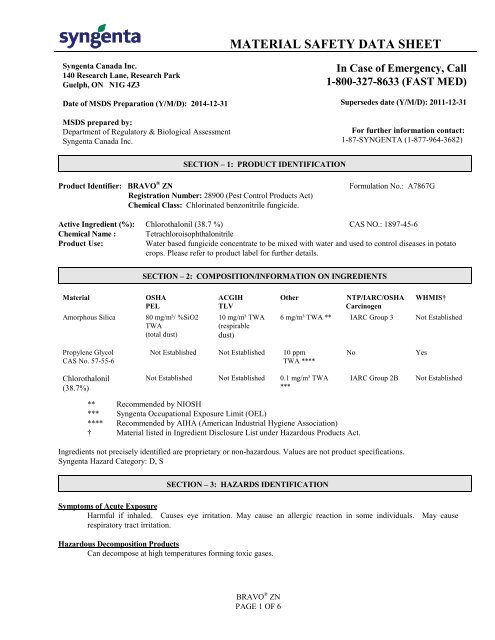
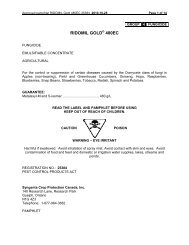
![gesagard 480sc [pamphlet] - Syngenta Crop Protection](https://img.yumpu.com/50945984/1/190x245/gesagard-480sc-pamphlet-syngenta-crop-protection.jpg?quality=85)
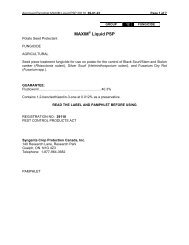
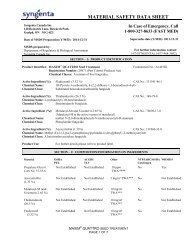
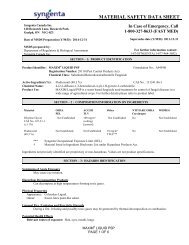
![ridomil Gold mz 68wp [bag] - Syngenta Farm](https://img.yumpu.com/49025229/1/190x245/ridomil-gold-mz-68wp-bag-syngenta-farm.jpg?quality=85)
